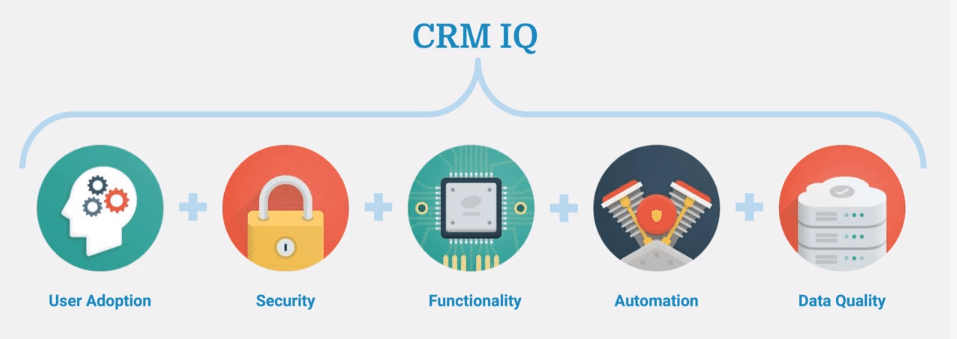5 Things That Every Modern CRM Should Have
When it comes to modern CRM technology, there is good and bad news. The good news is that CRM is now the largest software market. The bad news is that CRM is now the largest software market. I know. Mind-blowing, right?
Let me break it down for you. Today, we have dozens of CRMs flooding the market, and while that means that users have more choices, it also means that there is a lot of noise and confusion. Which CRM has the best price? Which one is more secure? How user-friendly are they? Which one will offer the best ROI?
While the specific needs of your business may vary based on industry, customer base, and unique requirements, at its core, modern CRM needs to be a hub for storing and managing its most valuable resource: customer data.
For this blog, we base our findings on the five core components that we consider every CRM should have: user adoption, security, functionality, automation, and data quality.
Let’s dive into these five components that affect how much value people are getting out of their CRM.
Here is how you can improve data quality:
- Look at integrations as a way to boost ROI
- Give CRM access to all customer-facing teams.
- Provide offline and mobile access to data to improve data accuracy
- Create reports that check for outdated information
These five core components working together can create the perfect CRM system.
1. Stellar User Adoption
There are always ways to improve user adoption and increase ROI. When it comes to your CRM, user adoption is one of the biggest challenges. Although most businesses are using a CRM, adoption rates are still quite low, with an average adoption rate across industries of 26%.
The cost of poor CRM adoption is twofold: underutilized investment and unmet business objectives. According to Forbes, nearly two-fifths (38%) of respondents stated that their problems were the result of people issues such as slow user adoption, inadequate attention paid to change management and training, and difficulties in aligning the organizational culture with new ways of working.
Visual representation of data is critical to get your employees to embrace your CRM and improve their efficiency. An improved visual interface, combined with the quality data you migrate into your CRM, will definitely improve user adoption and productivity.
Here are a few tips on how you could improve user adoption:
- Access all reports in your CRM instead of spreading them out on separate software and spreadsheets
- Limit the number of required fields
- Designate a CRM champion to get team buy-in
- Update all nomenclature to match internal lingo
2. Great Security
As data privacy (GDPR) and cybersecurity measures increase, so has the need for heightened data security. Companies need to have appropriate security practices in place in order to be able to make sure that their CRM can be used correctly. Often, companies are sensitive about adopting CRM due to poor security practices. They’re nervous about storing sensitive data on a system that could expose them to risks. Here are some good points for improved security:
- Set up access permissions based on roles
- Implement password rules (length or character requirements, expiration dates)
- Create a standard procedure for revoking access
- Implement Single Sign-On (SSO) or Two Factor Authentication (2FA)
3. Valuable Functionality
CRM software is one of the most important sales tools in sales reps’ arsenal, which means having a fully integrated, cross-functional CRM solution is crucial. Ask yourself these questions:
- What can your CRM system actually do?
- Can you add additional functionality?
- Can you automate a process or add a feature that you need and that would give you additional value?
All of these are valuable questions that, once answered, will help define your CRM’s value to your organization. Improve functionality by:
- Focusing on core functions of CRM rather than bells and whistles
- Considering all departments that are using CRM and how functionality fits into their specific use cases
- Optimizing over time instead of a plug-and-play approach
4. Increased Business Automation
With the right automation, CRM can save businesses a significant amount of time and money. CRM has evolved from being just big databases to a crucial business automation tool. Make sure that your CRM works perfectly together with your marketing automation tool to achieve the automation of business processes that your organization needs so badly.
Improved automation can:
- Look at CRM as an automation powerhouse instead of as a business Rolodex
- Have an overview of the entire customer lifecycle and add automation for marketing, finance, customer, and support (rather than just sales)
5. Amazing Data Quality
A component that truly elevates a CRM from a siloed database to a customer intelligence platform is the ability to generate actionable insights. Quality data is paramount for any organization. If you don’t ingest good data into your system, you won’t have good reports and analytics coming out. Be sure your CRM can apply artificial intelligence to recognize patterns in customer behavior and recommend actions for the best-predicted outcome.
Here is how you can improve data quality:
- Look at integrations as a way to boost ROI
- Give CRM access to all customer-facing teams.
- Provide offline and mobile access to data to improve data accuracy
- Create reports that check for outdated information
- These five core components working together can create the perfect CRM system.
Prioritizing Your Companies Needs Out of a CRM
While there are many other factors to take into consideration when measuring your CRM’s value and capabilities, prioritizing these five core components of CRM should help your organization run at full capacity.
Interested in learning more about what a modern CRM should be equipped with? Check out our infographic, “SugarCRM vs. HubSpot vs. Salesforce”.


